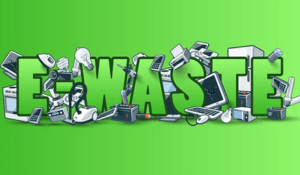E-Waste Management: An Overview
“I recognize the right of this generation to develop and use the natural resources of our land; but I do not recognize the right to waste them, or to rob by wasteful use, the generations that come after us.” – Theodore Roosevelt, 26th President of the United States
It is an undeniable fact that the world faces a major problem with waste materials today. We have depended on Mother Nature to decompose and dispose of all our waste for centuries. However, the kinds of waste now proliferating throughout our modern world- plastics, disposables, industrial, and electronics- are difficult to decompose, and end up causing adverse effects to the environment around us. For instance, how many of us know about the amount of land and water pollution caused by dumping electronic waste in landfills? And is it enough to make a difference?
The Rise of the E-Waste Problem
The end of the Second World War brought about an extended period of peace and stability. This gave a boost to innovations in the electronics field, and key advances in developing information technology gave rise to the information and communication revolution. And so began the era of increasing electronic waste!
Electronic waste can be broadly divided into 6 types: temperature exchange equipment, screens & monitors, lamps, large equipment, small equipment, and small IT and Communication equipment.
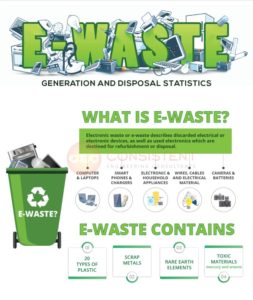
E-waste has become one of the major components of waste materials worldwide. According to the Global e-Waste Monitor, 41.8 million tonnes of e-waste was generated in 2014 globally; and only 16% of it was recycled and disposed of appropriately.
That number increased to 47.7 million tonnes in 2016! Out of that, unfortunately, only 20% was recycled and disposed of properly. According to the latest predictions, the figure is extrapolated to grow at 2 million tonnes per year. This indicates that by 2020, we face the disposal of 55 million tonnes of e-waste!
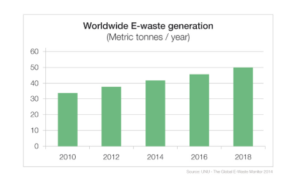
Source: The Global e-Waste Monitor 2017
The Global State of E-Waste Generation
From the above information, we can easily conclude that e-waste is a growing problem of global proportions. According to the UN reports from 2016 the amount of e-waste generated by continent was:
– Asia (18.2 Mt)
– Europe (12.3 Mt)
– North, Central, & South America (11.3 Mt)
– Africa (2.2 Mt)
– Oceania (0.7 Mt).
Oceania, despite being the smallest contributor overall, was the largest per-inhabitant contributor (17.3 kg/inh), only 6% of which was properly recycled. Similarly, though Europe is the second-largest contributor of e-waste per inhabitant (16.6 kg/inh) it has the best e-waste collection rate (35%).
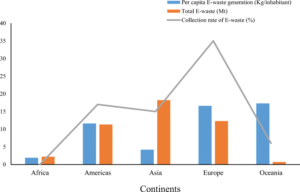
Source: Springer.com
Within Asia, the Gulf countries also certainly been affected by the e-waste issue. Because of the rise in disposable income, the higher standard of living, and the availability of electronic devices, e-waste has become a major issue in the GCC. In 2016, the GCC countries generated 600,000 tonnes of e-waste, and by 2020 are expected to contribute around 900,000 tonnes.
That is eerily close to 1 million tonnes, and the day is not far off when the GCC will exceed that amount.
Let us take a look at some statistics about e-waste generation and recycling at a global and regional level.
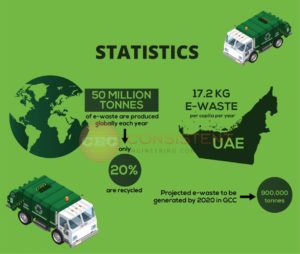
The Necessity of E-Waste Recycling
According to the Global e-Waste Monitor, 80% of the e-waste in the world is disposed of in landfills or in other unsafe ways. Such improper disposal is harmful due to multiple factors:
Toxic Materials: E-waste usually contains toxic materials such as Arsenic, Cadmium, and Mercury which seep into the groundwater and soil. This results in the harmful effects of land and water pollution.
Waste of Raw Materials: E-waste contains a number of raw materials- plastics, metals, ceramics- which are lost if the waste enters landfills. The estimated value of all raw materials in the e-waste generated in 2016 is approximately 55 billion Euros!
Loss of Rare Metals: E-waste also contains traces of a number of rare metals like gold, silver, and platinum which are lost to us when the waste is thrown into landfills, and can’t be reused
Role in Carbon Footprint: Thus, throwing e-waste in landfills denies us the opportunity to reuse the composting materials. This, in turn, means that we must manufacture/process more materials for our use, which leads to an increase in carbon footprint
Adverse Health Impacts: There is a huge unorganized sector handling the disposal of e-waste, especially in developing countries. There is a risk of this untrained personnel suffering from skin damage or other health problems due to a lack of proper precautions while handling e-waste.
A study published by the Royal Institute of Technology in Stockholm, Sweden says that workers even as young as 6 years old are routinely exposed to hazardous materials and inhalation of toxic gases through direct handling of discarded electronics!
Taking into consideration all the economic, environmental, and social aspects of the issue, global authorities have come up with scientifically established, sustainable methods of e-waste recycling and disposal. This revolves around separating the different components of e-waste to get raw material which can be reused, and safely disposing of the rest.
Advantages of E-Waste Recycling
- Conserves Natural Resources by recovering valuable materials that can be used to make new products. This ends up saving energy, reducing pollution and GHG emissions, and extracting fewer raw materials from the earth
- Protects Environment by providing proper handling and management of harmful chemical substances like mercury, lead, and cadmium
- Creates Jobs for professional recyclers and creates a secondary market for recycled materials.
- Reduces Landfill Creation by reducing the waste going into landfills
Over the last decade, all the major nations in the world have taken up the cause of sustainable recycling of e-waste, to varying degrees of success.
One of the most successful examples in Sweden, which has a mature recycling system with one of the highest e-waste recycling rates at 51.6 percent. The Swedish government has achieved this with a strong Extended Producer Responsibility (EPR) legislation, where the producers of electronic items are accountable for the disposal post-consumption. Hence, the manufacturers organize takebacks in which people can return their old electronics. To facilitate the organized structure of recycling, the Swedish system tracks the quantity of e-waste generated and processed and its composition, through Data Collection and Sharing. All the stakeholders involved in the e-waste recycling process educate the public and carry out Collection and Awareness Campaigns at the local or national level.
Thus, Sweden’s ‘Zero Waste Policy’ has resulted in almost 99% of Sweden’s entire waste being recycled, to the point that Sweden is now importing waste from other countries!
Creating Public Awareness
Unfortunately, the issue runs deeper than a simple matter of government policy and implementation. For the majority of the public to take part in recycling, the importance of recycling e-waste needs to be inculcated with education.
Sweden has implemented educational policies for the last two decades, the result of which is that everyone from children to the elderly is aware of the importance of proper recycling.
Until the large and populous nations like China and India do not take up this educational drive at a grass root level, the implementation of global standards and policies will yield but a partial result.
“The second-hand market in India is very strong,” Mr. Karan Thakkar, Founder, and Director of leading Indian waste management firm EcoCentric Management reflect on the Indian scenario. “It also gives employment to a number of people; and certainly, individuals expect a price which the electronic device commands even if dead, owing to available spare parts. The question is always, who should bear the cost of recycling? Should it be the companies manufacturing it in the first place, the consumer buying it, or the government? There is no ownership, which should change.”
He recalls the progress India has made since the beginning of EcoCentric. “When we started our journey people did not think that a phone or a laptop or even a tube light is potentially hazardous. Electronics were always thought of as assets. But a decade later the scenario is much better. At least in metro cities, individuals are constantly seeking avenues to dispose of their e-waste in an eco-friendly manner. Many groups have worked towards this- companies, recyclers, NGOs, and government bodies.”
For countries like India, this is certainly a good start towards proper e-waste management. But what of developed countries with high incomes and easy availability of electronics? Let us take the example of the UAE.
Managing E-Waste: The UAE Perspective
The United Arab Emirates is one of the most developed nations in the world. However, the recent spurts in development and the high per capita income have led to an extreme rise in e-waste in the country. In 2016, the e-waste generated in the UAE was 134,000 tonnes, and the average UAE resident is estimated to contribute 17.2 kg of e-waste per annum.
Taking this situation into account, the UAE government has taken a number of steps towards proper disposal of e-waste. Recently, it established the Integrated Waste Management system to meet the ambitious target of diverting 75 percent of all municipal solid waste (including e-waste) away from landfills by 2021 as per National Agenda of the UAE Vision 2021. The following infographic gives an account of the steps taken to combat e-waste in the UAE.
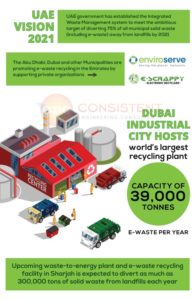
Social Campaigns in the UAE
As can be seen from the infographic, the UAE government is certainly taking major steps to combat e-waste. However, any mission cannot succeed without the active participation of all the stakeholders. With the rise in awareness about e-waste, a number of public campaigns have been carried out by organizations in the UAE to educate the public as well as recycle more and more electronic waste.
One such campaign was conducted by Consistent Engineering Consultants, an MEP consultancy specializing in sustainable building and renewable energy. As a part of its Diwali celebrations, Consistent conducted an E-Waste Collection and Recycling Drive throughout its offices and sites across Dubai. As word of the campaign spread, even the ordinary residents of Dubai joined in to contribute to the electronic waste. Similarly, the Mumbai office of Consistent also collected e-waste in its vicinity. To properly collect, recycle, and dispose of the e-waste, Consistent partnered with the Dubai Municipality-approved E-Scrappy Recyclers. The campaign went on to involve more than 6 prominent companies in Dubai.
“In less than two weeks, we managed to collect almost a tonne of e-waste,” says Mr. Sagar Kulkarni, MD, Consistent Engineering Consultants. “The enthusiastic response we received from our own team, our partners, as well as the residents of Dubai, only cemented our belief that this initiative is a crucial one in today’s time.”
Another such campaign was carried out by the Indian Ladies Association in Abu Dhabi. The members of this community organization conducted an e-waste collection drive in the UAE capital, spreading the word through social media. The collected mobile phones were handed over the Emirates Environmental Group for reuse or recycling purposes.
Thus, along with on a governance level, a corporate level as well as an individual level, there is an increasing awareness regarding the importance of proper e-waste management.
Conclusion
“E-Waste is one of the major issues facing the world today,” says Mr. Sagar Kulkarni. “A threat which has the potential to affect the quality of human life, which affects as many as 6 out of 17 Sustainable Development Goals, needs to be dealt with seriously. In the years to come, all stakeholders must focus on bringing more and more electronic waste under proper recycling and management.”
Creating a change in mindset requires first creating awareness. If awareness spreads to all levels and strata of society, people will come together and work to make our planet a ‘zero e-waste’ one in the coming decades!
(This is a sponsored guest post authored by Ashutosh Dixit, Consistent Engineering Consultants. The views expressed in this article are the author’s own.)

